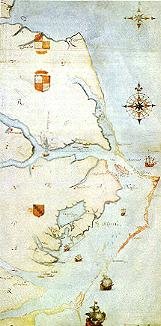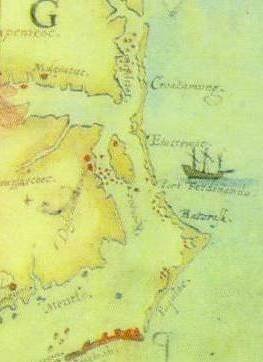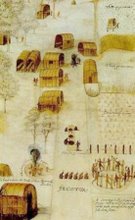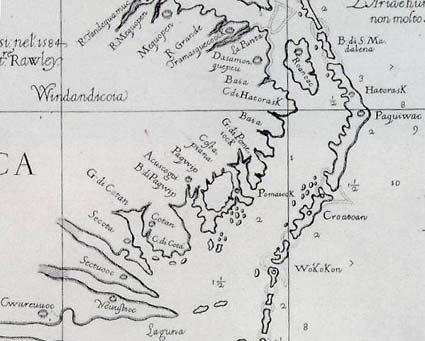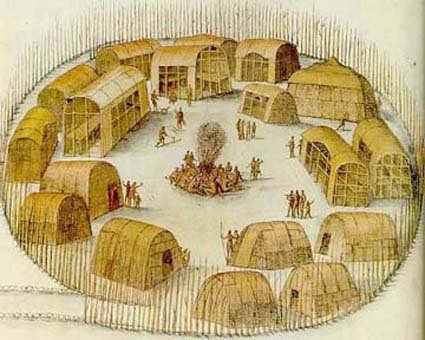No plans for vessels used in the Roanoke voyages are known to exist, but reasonably accurate inferences about those vessels can be drawn from contemporary paintings, construction and performance records, woodcuts, and maritime treatises.
The wooden sailing ships of the period, while much trimmer and sleeker than their tub-like fourteenth-and fifteenth-century ancestors, had considerable strength, durability and maneuverability. Rather than battering and slamming their way through the forces of a North Atlantic gale, the typical sixteenth century English ship was able to slip and bob through the waves with comparative ease.
Disasters at sea were rarely caused by the structural failure of a ship. Typically, the hull or shell of the vessel was either clinker-built, that is, with plank edges overlapped and fastened with nails; or carvel-built, with planks laid flush, edge to edge, over a skeleton frame. Both methods of hull construction had advantages and drawbacks.
The
clinker-built ship, while extremely strong and durable, was difficult and expensive to repair, the services of a master shipwright being required. Moreover, gunports, which were cut through the overlapping, weakened the hull significantly. In spite of these drawbacks, the average life of a typical ship was an impressive sixty-five years. Even though this method of construction was being phased out by the mid 1540s, it is likely that some of the vessels that took part in the Roanoke ventures were clinker-built.
The
carvel-built of skeleton-frame ship was also strong, durable, and difficult to repair. The skill of a master shipwright was not always required, however; a competent carpenter could handle many repairs and alterations.
Whether a merchantman or a ship of war, a sixteenth-century vessel contained a vast array of small pieces of wood, nails, iron bolts, washers, wooden pegs, and knees or braces. All seams were made water tight with a caulking of tarred hemp fibers. The result of the shipwright's art was a springy, flexible vessel able to work under the various and variable stresses exerted by the wind; the weight of cargo, the crew, and the ship itself; and the violent impacts of the sea.
The vast majority of sixteenth-century oceangoing vessels were three-masted and
square-rigged. On a square-rigged ship, the large main square sails were laced to a yard or bar, which was attached horizontally to a mast. In addition to the square sails carried on the main and foremasts, square-rigged ships of the period also had, on the aftermast, a small lateen, or triangular sail which acted as a stabilizer. The square-rigged ship of the Elizabethan era was able to sail well to windward, that is, approximately in the same direction from which the wind was blowing. The versatility of this particular style of rigging enabled mariners to adjust sails to meet constantly changing wind conditions. Because of the strength and durability of its hull, its maneuverability, and its adaptability, the three-masted, square-rigged ship was the mainstay of the European voyages of discovery and exploration.
In sixteenth-century England, the size of a vessel was estimated in terms of
tunnage --the ships capacity to carry 252 gallon tuns of hogshead barrels of wine. A 50-tun ship could carry fifty hogsheads. The tun was a measure of volume, not weight, and it was hardly uniform. The capacity of a Spanish tun, for example, was considerably less than that of an English tun. Thus a Spanish vessel of 50 tuns was not the same size as a 50-tun English ship. During the Elizabeth Era,
tonnage, a more accurate and sophisticated measurement system based on a ship's dead weight and its displacement of water was in the early stage of development. As a system for standardizing the measurement of ship size, it was not uniformly applied to English shipping for many years thereafter. Though sometimes used interchangeably by post-Elizabethan writers, tunnage and tonnage are not synonyms.

The majority of ships used in the Roanoke ventures were privately owned, well-armed merchant ships ranging in size from 20 to 400 tuns. Other than names and tunnage, very few details about the vessels survive. The lack of information is complicated by the inexact system for estimating ship size--one ship could be listed with different tunnages. Identification of the vessels is made more difficult--and in some cases rendered impossible--by the Elizabethan practice of renaming ships often. Sir Francis Drake's Pelican (Golden Hind) is famous enough to be traceable, but most of the vessels associated with the Roanoke voyages are not. Contemporary descriptions of these vessels vary. A vessel called one thing in one document might be called something else in another. Further, more-or-less standard modern usage and definitions have little in common with sixteenth-century terminology.




